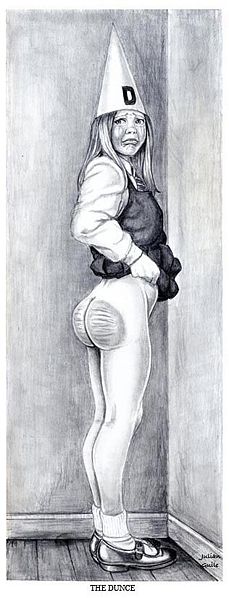Dunce cap

A dunce cap, also variously known as a dunce hat, dunce's cap, or dunce's hat, is a pointed hat. In popular culture, it is typically made of paper and often marked with a D or the word "dunce", and given to schoolchildren to wear as punishment by public humiliation for misbehavior and, as the name implies, stupidity. While this is now a rare practice, it is frequently depicted in popular culture such as animated television series.
A very similar practice on the European continent was a paper head dress known as donkey's ears, as a symbol of 'asinine' stupidity.
Origins
The word "dunce" comes from the name of John Duns Scotus, a Scholastic whose followers were called "duns" or "dunsmen". Duns Scotus wrote treatises on grammar, logic, and metaphysics which were widely used as textbooks in the medieval British universities. As the English Renaissance began and the new learning superseded Duns Scotus' theories, his adherents obstinately refused to acquiesce. The word "dunce" then began to be used by humanists to ridicule the Scholastics, gradually acquiring its modern meaning of "someone who stubbornly refuses to learn anything new."
Duns Scotus
King Philip IV of France wanted to tax the church in order to finance his war in England, but Pope Boniface VIII threatened to excommunicate him instead. Duns Scotus supported the pope and was banished from France, later taking up a university professorship in Germany. Those who disagreed with Scotus' teachings started referring to his supporters by the word 'dunce', which meant 'stupid or dull witted'. His books on theology, philosophy, and logic were university textbooks. His followers were later challenged by their opponents about what was perceived as a system of hair-splitting and distinctions; their obstinacy over an increasing array of challenges posed first by Renaissance humanism and then by Protestant Reformation led to the term "dunses" to denote fools in general.
According to the Oxford English Dictionary (2nd edition), "dunce cap" didn't enter the English language until after the term "dunce" was so transformed. Dramatist John Ford's 1624 play The Sun's Darling is the first recorded mention of the related term "dunce table," a table provided for duller or poorer students; "dunce cap" appears first in the 1840 in a novel The Old Curiosity Shop by Charles Dickens.
Chat rooms • What links here • Copyright info • Contact information • Category:Root